
Researching The US Online Grocery Shopping Experience and user hesitation
UX Researcher
UW-M Coursework
Dec 2022

🔸 The growth of technology has led to a big change in how people function in their day-to-day job. Along with technological developments, the pandemic has pushed people to shop for groceries online. Which in turn has led to a lot of competition in the US food and grocery industry.
🔸 The food industry in the US is huge! In 2020, total grocery sales across all channels reached $1.40 trillion, up more than 12% from $1.24 trillion in 2019. According to data from Digital Commerce 360, convenience is now the main reason why people purchase food online.
🔸 The majority of consumers cite time savings (61%), convenience (57%), and avoiding lengthy lineups in stores (46%) as the main benefits. Concerns about COVID-19 were the fourth-ranked motive, reported by 38% of respondents, which they used as an excuse to avoid trips to the store.
🔸 With growing demand and changes in the habits of people, big industries are struggling to provide a seamless digital experience to their customers.
🔸 Customer expectations are growing and therefore grocery retailers have to figure out how consumers behave differently when shopping online and what can be done to attract more customers to shop online.

💭 How can we… deepen our understanding of the current grocery shopping systems in order to make the process more efficient and cost-effective (customer satisfaction)?
🔸 What can we do to attract more people to online grocery shopping platforms?
🔸 What are the pain points of the current grocery shopping system?
🔸 What can be done to help grocery shoppers avoid waste?
🔸 Based on our topic, we planed to use user interviews (Opportunistic and Semi-Structured) and user surveys as our research method.
🔸 Interviews helped us understand consumer behavior better and the users were able to tell their point of view in detailed. After understanding the user's point of view via interviews, we then constructed specific questions around the topic and put out a survey to narrow down a particular area of focus that needs our immediate attention and benefits users more.
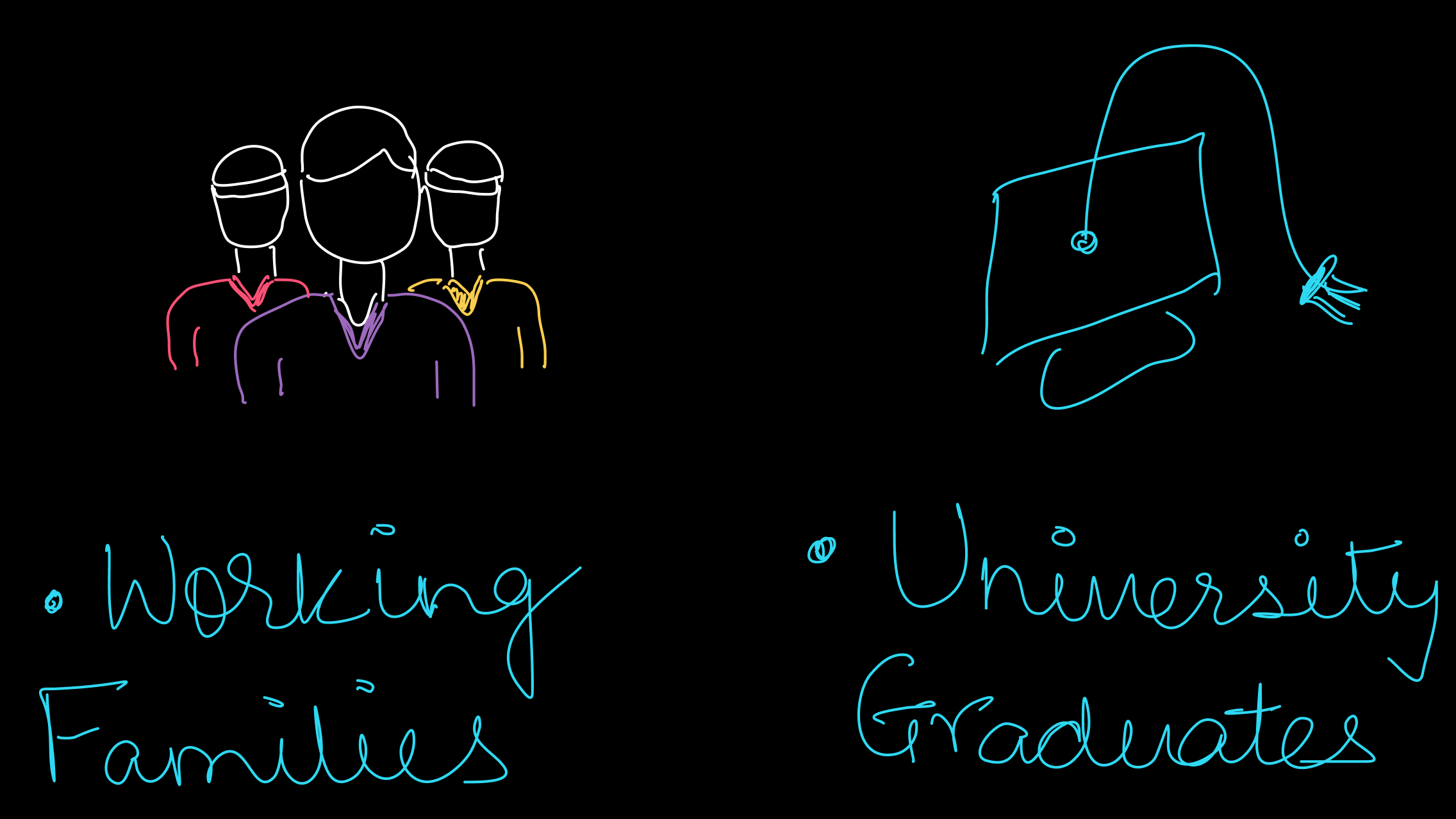
🔸 Madison is a young college town, so we targeted college students and working families. We observed people in and around grocery stores with proper consent (we were not creepy, I promise!). For interviews, participant observations and surveys we recruited college friends, work colleagues, neighbors.
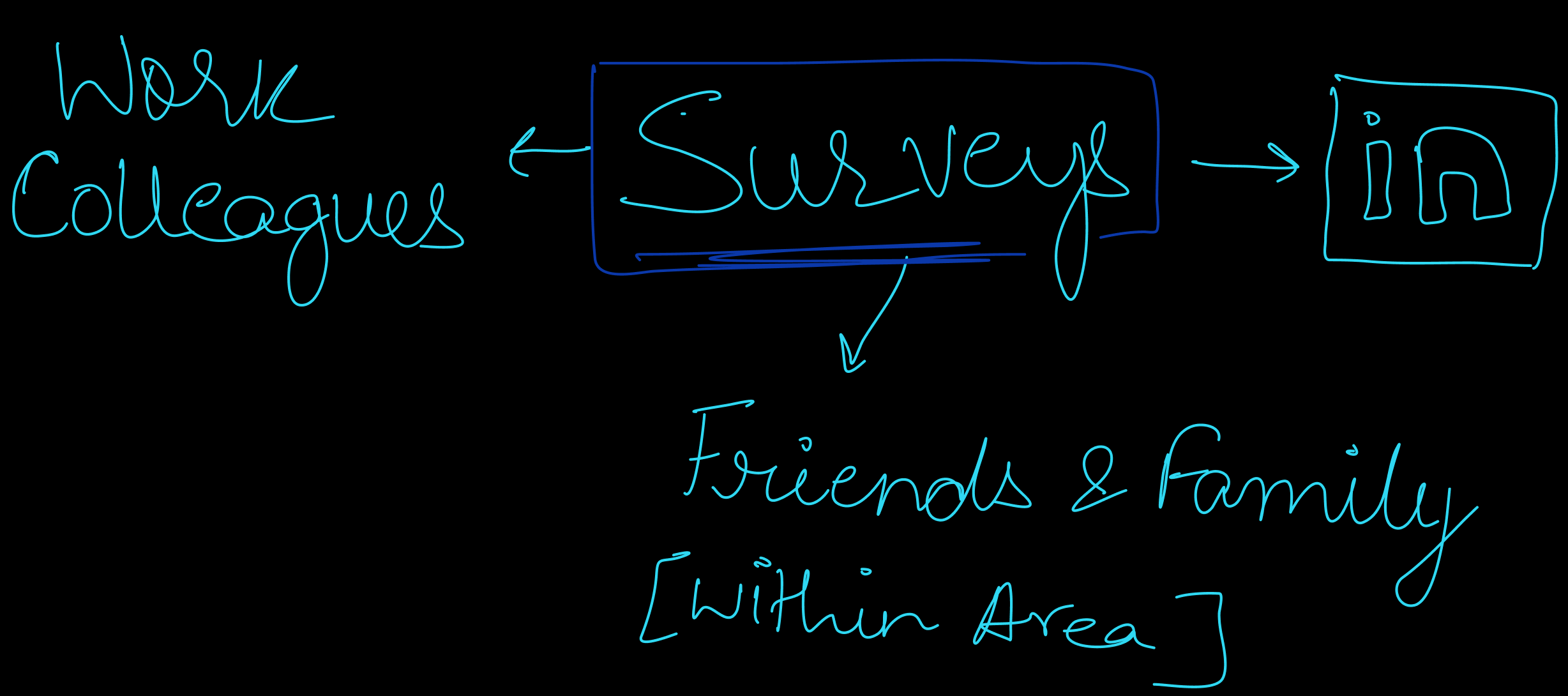
🔸 For surveys we also used social media platforms to increase outreach (mostly LinkedIn).
🔸 As we are very well aware, amazon has dominated almost every market. Now, Amazon has introduced a new way of shopping for groceries - Amazon Dash Cart. The Dash Cart allows you to skip long checkout lines and directly roll out the items to your car.
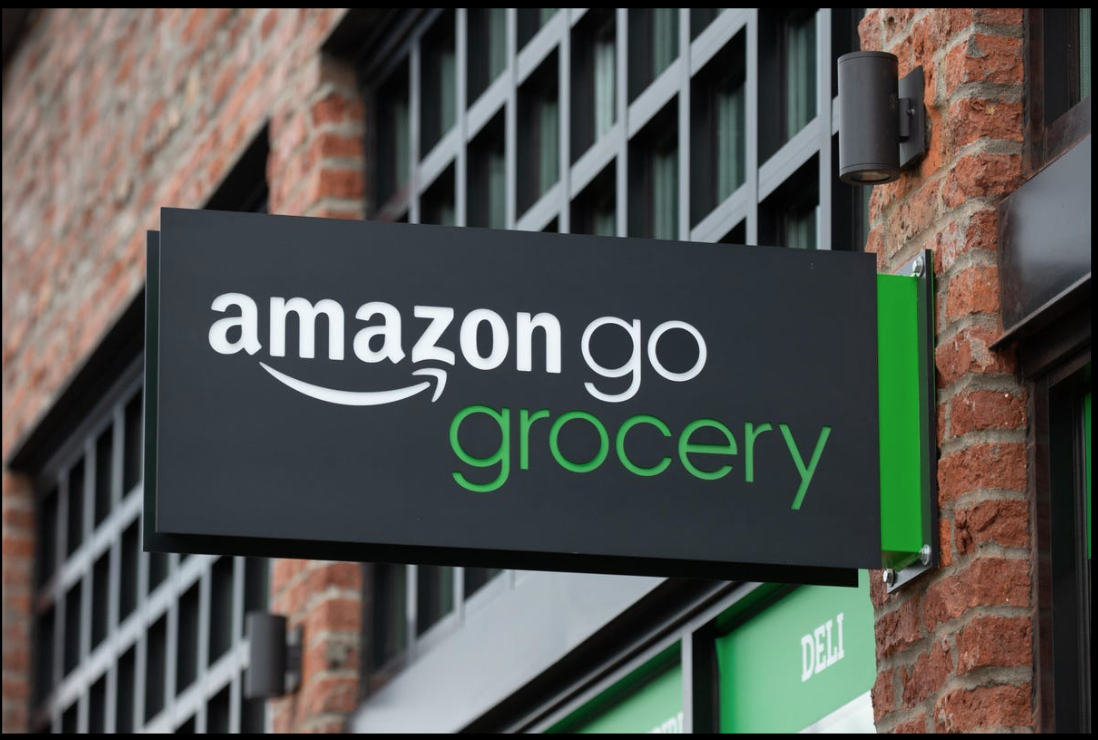
🔸 The way this works is

The cart contains a built-in weight scale and a screen where you can watch your live receipt, among other useful features for grocery shopping.
🔸 This allows the user to save a lot of time by not having to stand in a long billing queue. It is also linked to your application, so you can browse through all the items you have placed in your cart and make a purchase once you reach home.
🔸 In 16 Amazon Fresh outlets, you can use the Dash Cart for your shopping. In the upcoming months, Whole Foods Market in Westford, Massachusetts, as well as a number of Amazon Fresh locations across the country, will start selling the latest version of the Dash Cart.
🔸 Putting Amazon aside with its Dash Cart concept, there’s still a lot of competition among the traditional style of online grocery shopping with Big Box retailers leading the race. Big Box retailers that are on top of most people’s minds are Walmart, Costco or Kroger according to the U.S Online Grocery Report 2021.
🔸 This leads us to believe that offline retail giants are also the ones making the most impact on online platforms, most likely because of the reputation and trust they have already instilled in consumers.
🔸 Discount grocers like Aldi and 3rd party platforms like Instacart, Postmates etc still have to work on instilling that trust in people but still enjoy a fair share of the market.

🔸 There is no one player that stands out the most with only minimal margins between each of them. But when it comes to online grocery shopping, 3rd party platforms like Doordash, Instacart, Amazon Fresh, Postmates are the ones which people use the most.
🔸 This is mainly because they have done a pretty good job in establishing their brand awareness. But even brand awareness is influenced by different age groups targeted as reported by the U.S Online Grocery Report 2021.
🔸 However, this metric is very unreliable and unstable cause brand awareness can be influenced by a lot of reasons. So again there is no one major winner here. This brings up a question of why no one platform has been able to figure out consumer needs.
🔸 When it comes to business models, e-grocery models like Instacart, Postmates etc have a slight advantage over the traditional Big Box retailers. Their delivery model and ease of payment might be playing a big role here.
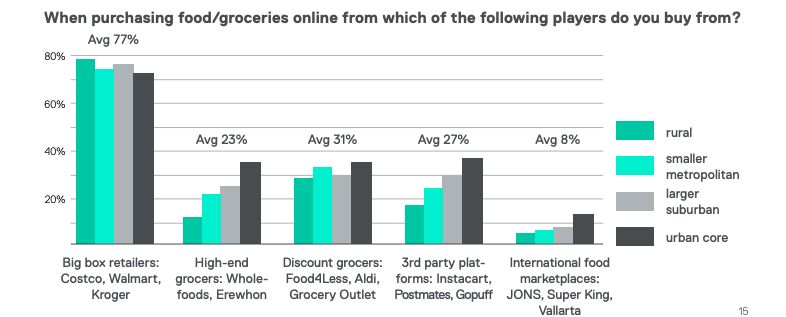
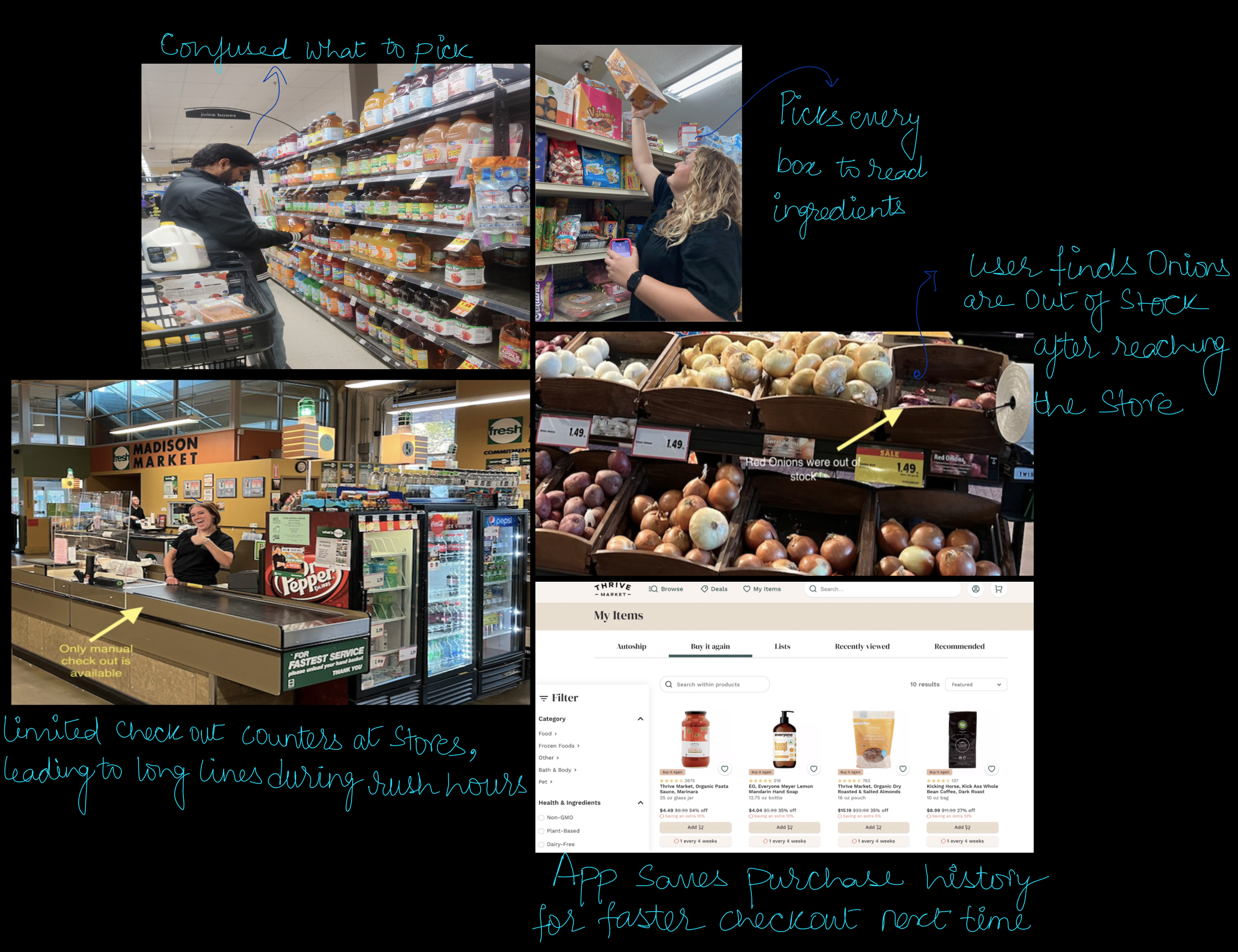
🔸 We conducted a contextual inquiry which helped us better understand consumer behavior and listen to their stories. After understanding the user's point of view, we then constructed specific questions around the topic and put out a survey to analyze shopping trends and highlight a particular area of focus that needs our immediate attention and will benefit users more.

🔸 What people feel about grocery Shopping

🔸 What people expect of online apps
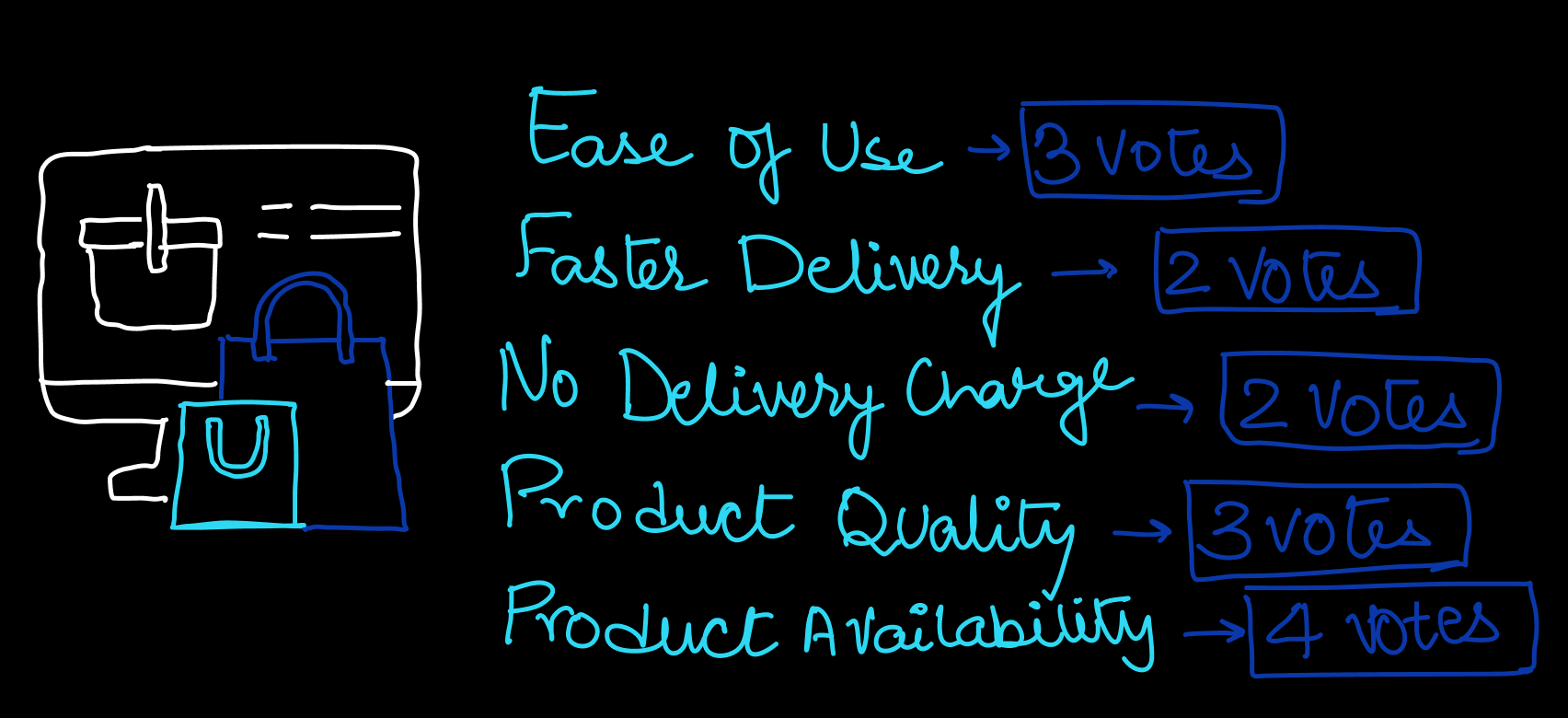
📌 50% people from our survey feel that discounts/coupons will encourage them to shop online
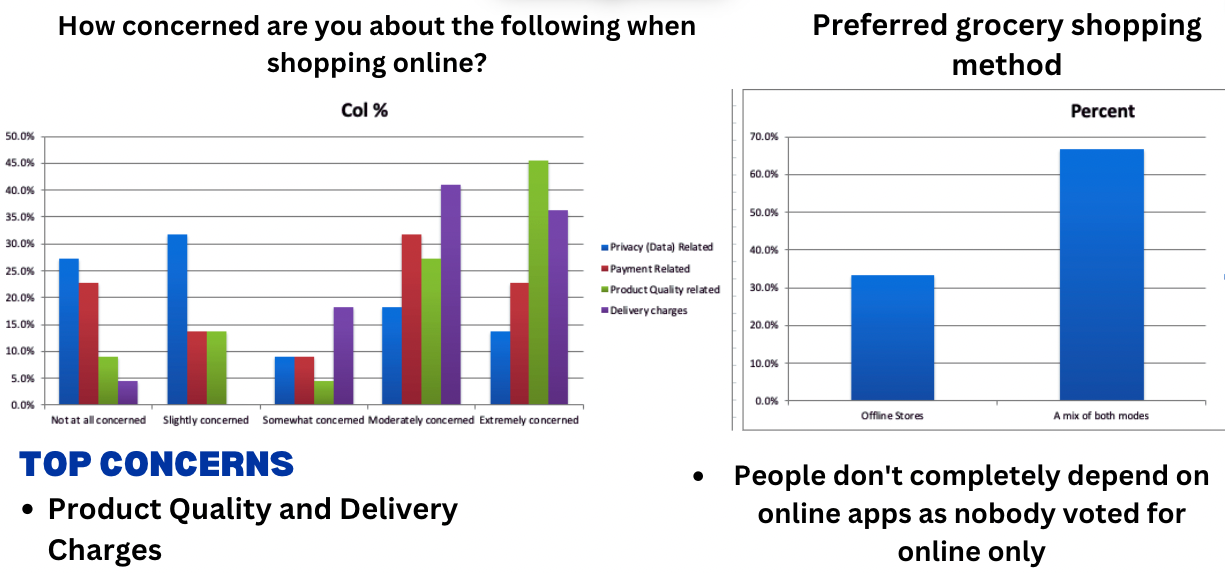
📌 37.5% people from our survey rated their online shopping experience as a solid 8
🔸 With so much qualitative data, we realized the best way to sort and organize this data is via affinity mapping.
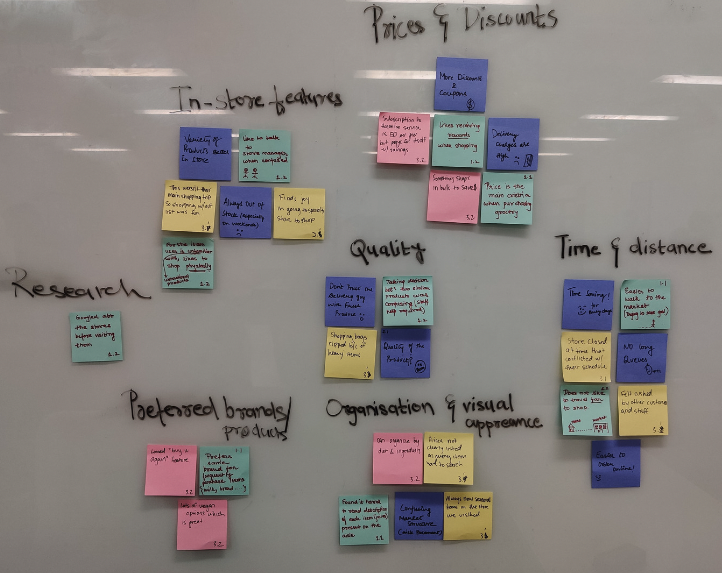
Prices & Discounts
🔸 Participants confirmed that the most critical factors determining their purchasing decision are prices and discounts. Especially in this economy!
Research
🔸 Many users research the store, website, or application from where they are thinking of shopping for reviews. They also do price comparisons for the products on multiple platforms.
Quality
🔸 The quality of products is a worrying point for users, especially ordering online. Users complained receiving 'near to expiry date' products while ordering online.
Preferred Brands/ Products
🔸 Users like to stick to one or two particular brands regarding certain products they want or may use daily especially while ordering online to avoid unexpected surprises.
Organization & Visual Appearance
🔸 Visual appearance is important to people when shopping online or offline. If Items are not appropriately arranged or visually appealing, the user's decision might be impacted when choosing an item.
Time & Distance
🔸 If the store is located far away or if the delivery is not fast, the user might not even consider going there regardless of the quality and number of options offered.
In-store Features
🔸 Many users prefer in-store shopping because of certain features offered by the store like the staff guiding and helping you find stuff. Some people find it joyful to shop in store for the immersive experience and the ability to carefully select their items.
💭 So what does our average user, in our case a grocery shopper really need?

📌 You might have 99 problems but, fast and free delivery of your groceries shouldn’t be one!
🔸 After gathering all these data points, we wanted to create an ideal user persona for our case study.
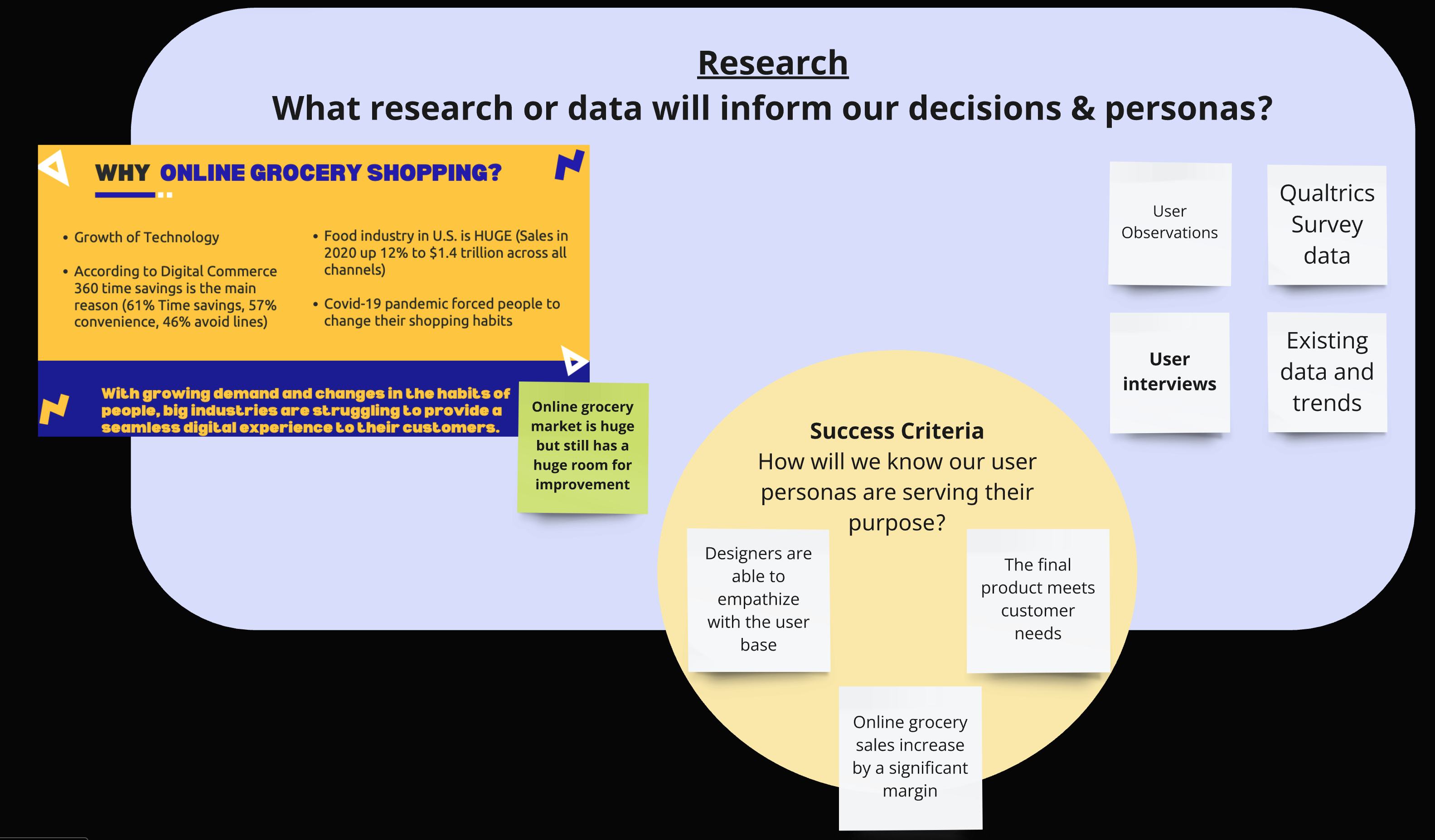
🔸 We wanted to make sure that creating user personas was indeed the right way forward and that it is based on informed decisions.
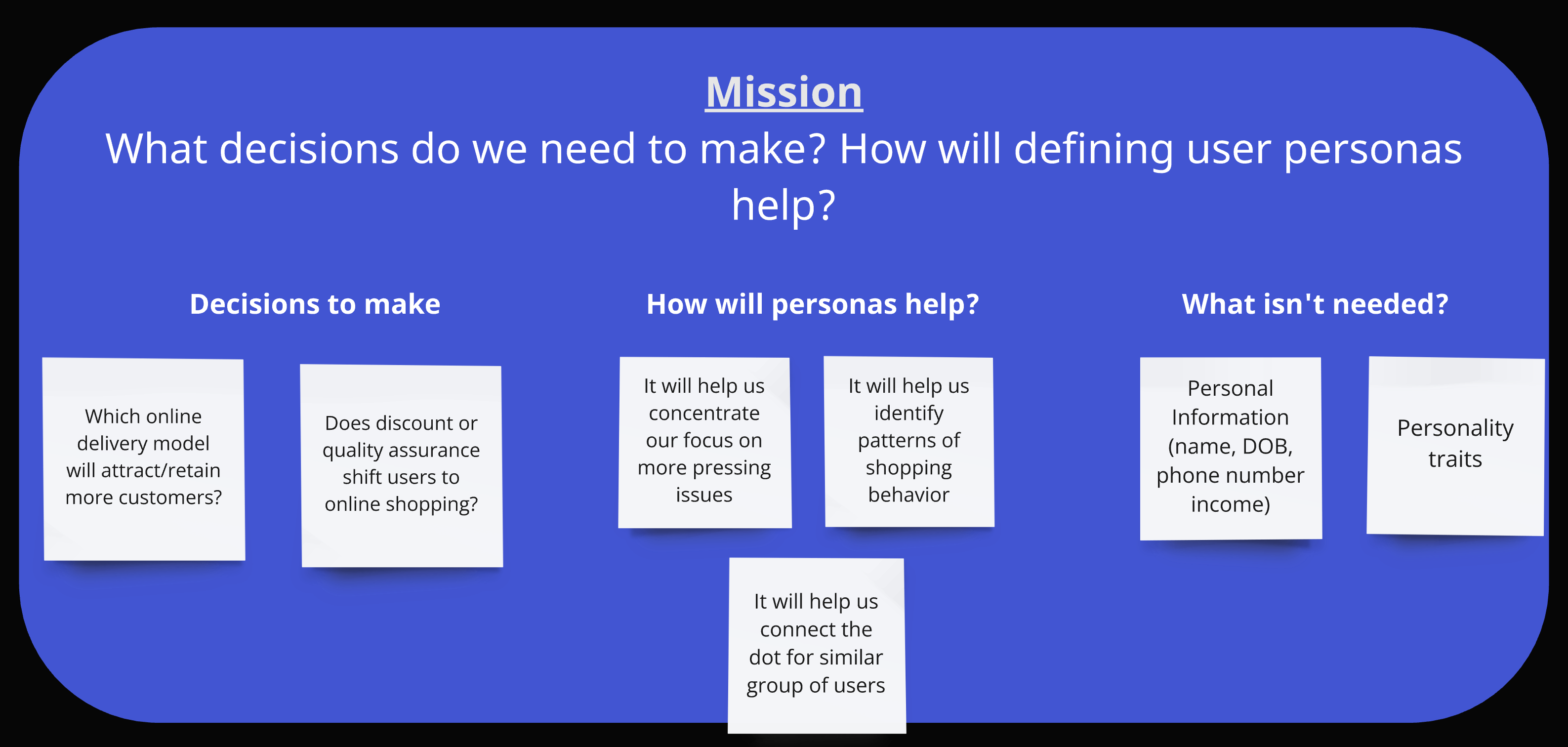
🔸 Finally after all that deliberation, meet Bob 👋
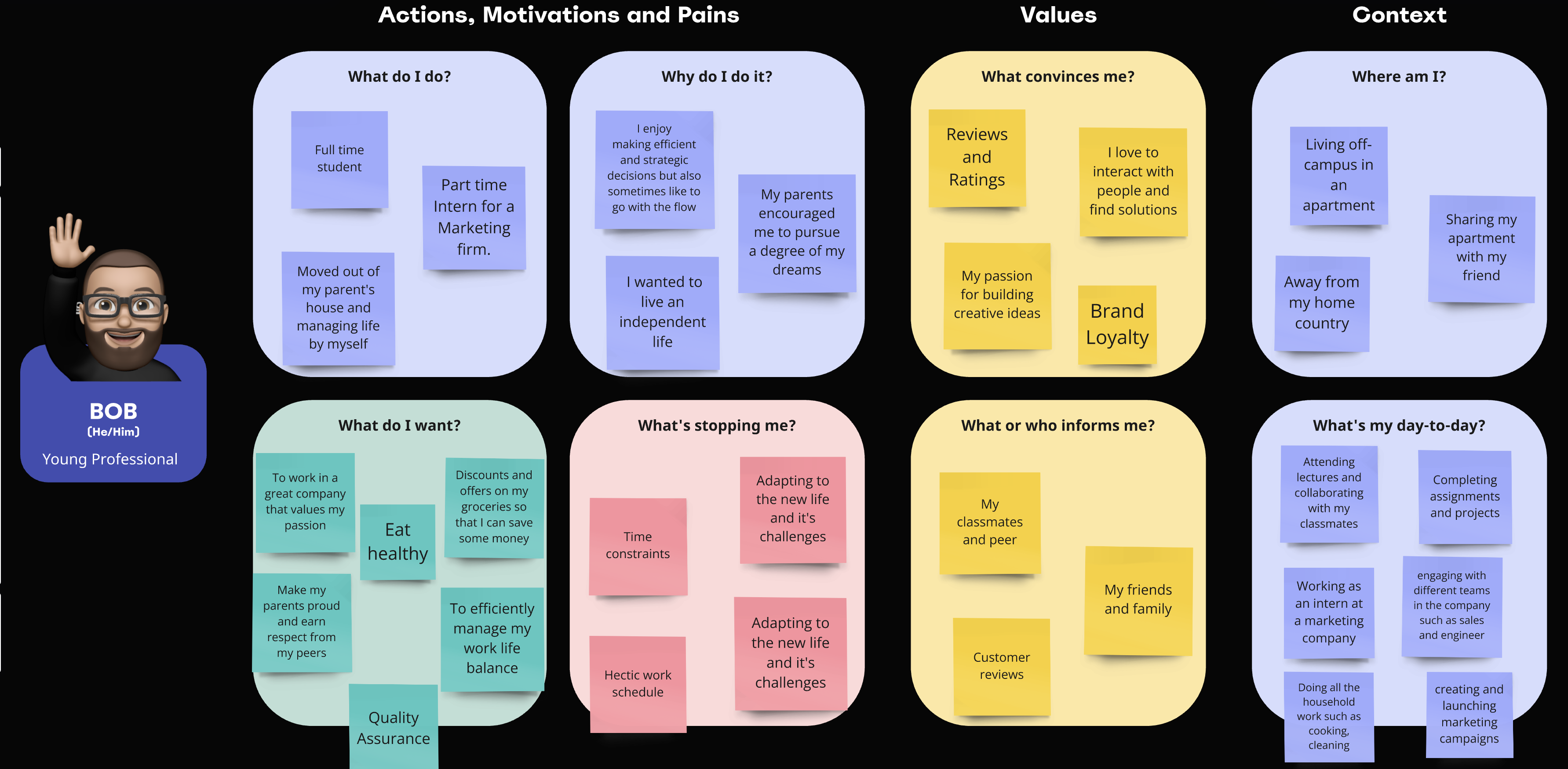
🔸 Our survey showed that people are unable to shop for their groceries because of time constraints. They are either full time students or young working professionals who due to their hectic schedules have to resort to buying groceries online even though they don’t fully trust the quality or have to pay high delivery charges.
🔸 Most of them have limited salaries so they are always looking for ways to save money on groceries because it’s a significant chunk of their expenses.
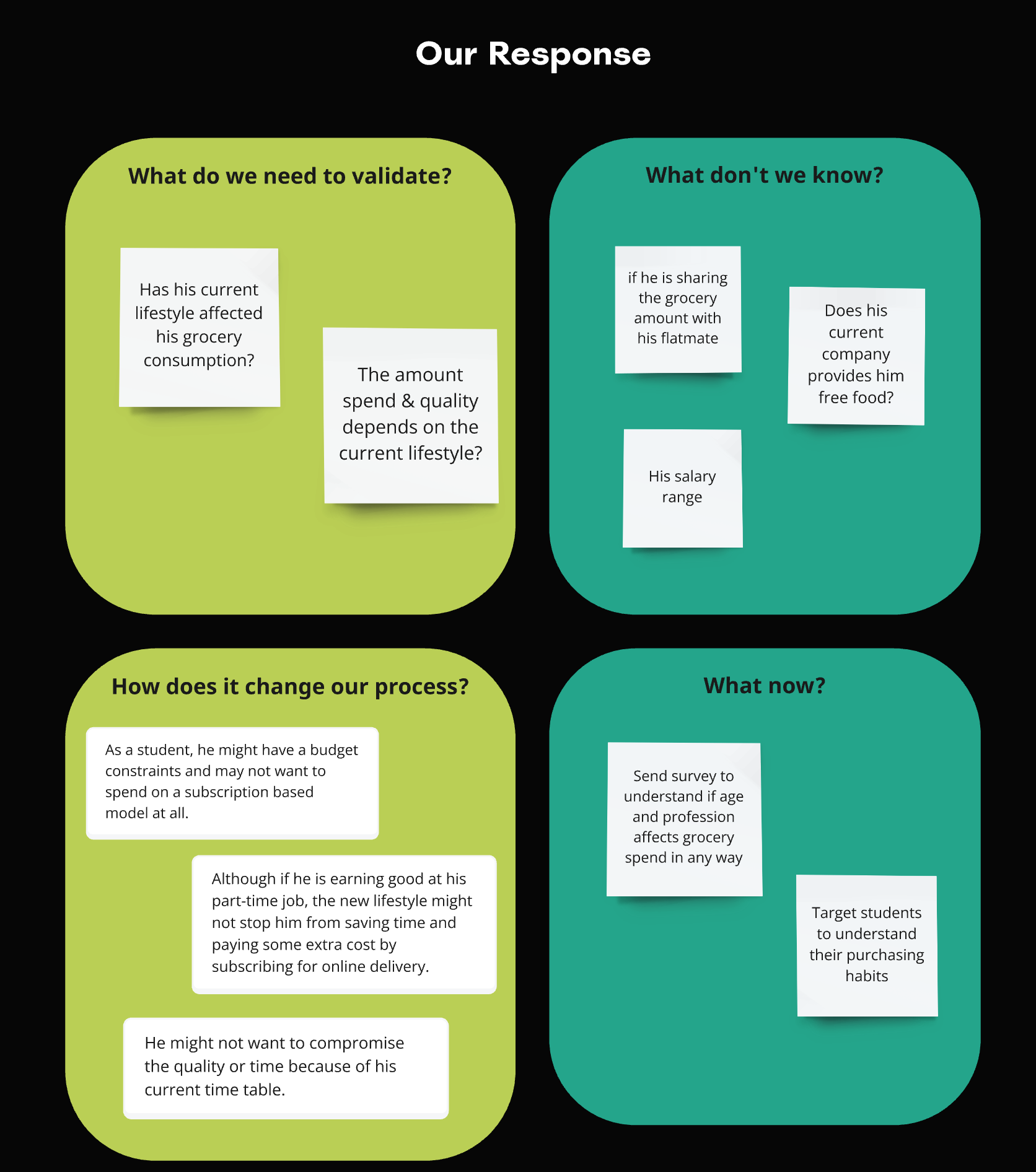
🔸 We are mapping out all the stages of ordering groceries online starting from logging into the app/site after which the user will browse through the items they need, add them to the cart, checkout their cart by paying for them. While paying for the groceries they will also mention their delivery method, add address etc.
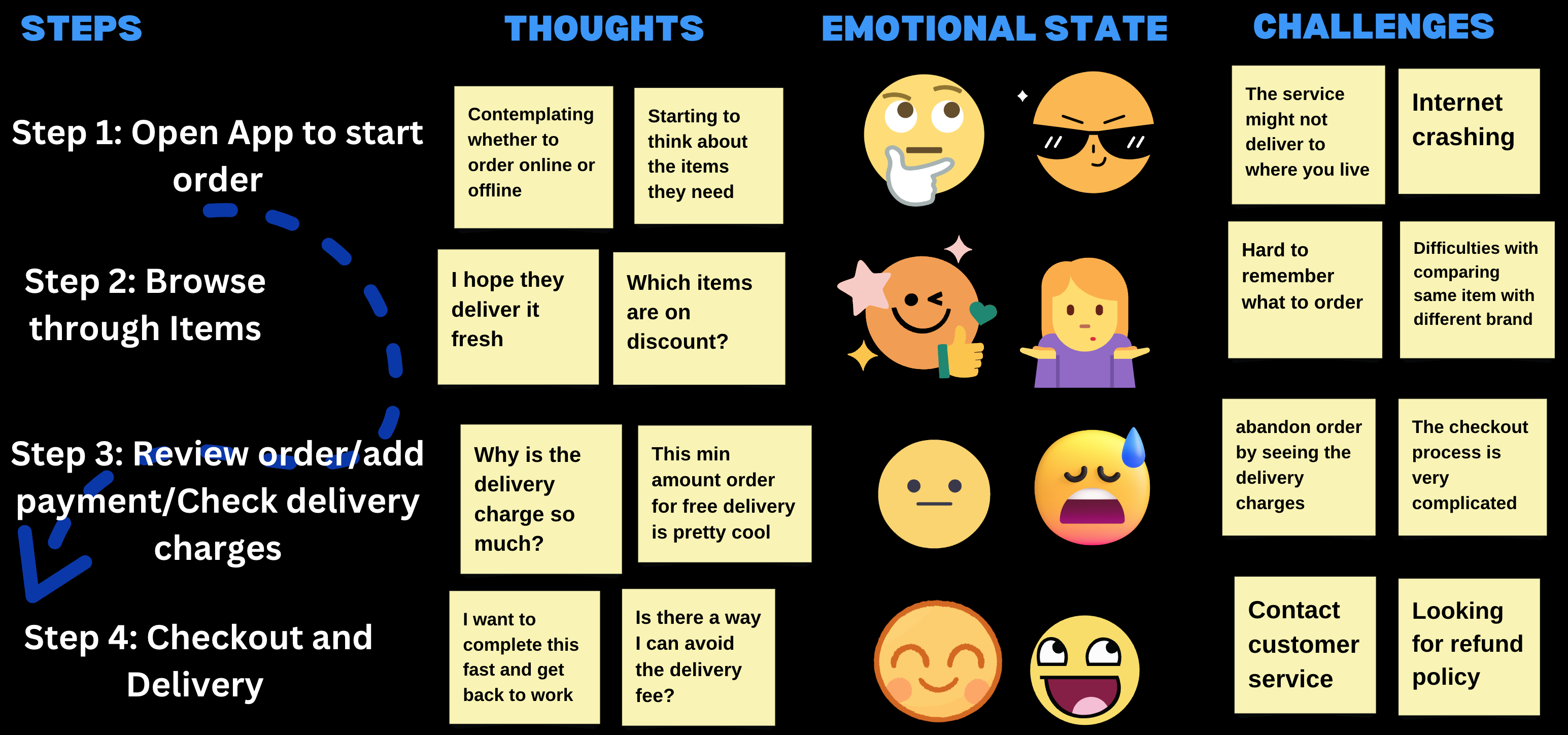
🔸 The checkout page is the area where our team’s attention was drawn. A lot of users were unhappy or abandoned their orders after seeing the delivery fees or the subscription fees.
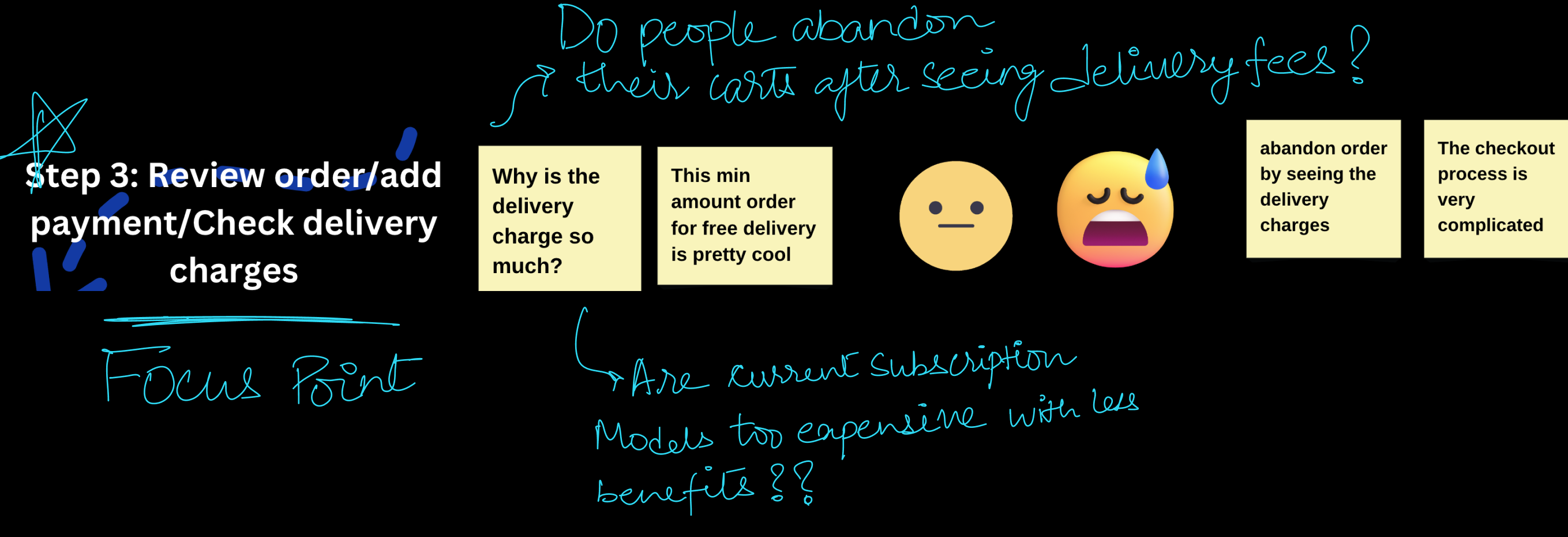
🔸 So, we decided to capture the feelings and thoughts of customers at the checkout page with more precision than other stages. 'Do people abandon their cart after seeing the delivery charges?' or 'Do they feel that the current subscription option is too expensive with very little benefits?'
🔸 Our team now focused on researching how to get customers their groceries in a cheaper and efficient manner.
🔸 For this we decided to test out two delivery models and see which one users pick or feel better about. One, we displayed a subscription based model wherein users can buy a monthly or annual subscription and enjoy free delivery with no minimum order and second, we will give customers an option to go with a minimum amount order delivery model. Here there will be a minimum amount set by the platform above which delivery will be free for even non-members.
🔸 Our research aimed to retain and garner more traffic for online grocery platforms. We wanted to experiment with different payment/ delivery models and see which ones are preferred by customers.
🔸 We plan on displaying the information regarding the minimum order amount and subscription option in explicit banners either on the homepage of the app or at the checkout page to see which option people choose.
🔸 Most online platforms have this kind of information a little hidden under some tab so people only get to know about delivery charges only at checkout and see that they sometimes don’t go ahead with the order.
🔸 We want to see if making this explicit at the beginning of their shopping process will help them make informed decisions.
🔸 Our dependent variable is the delivery charge model.
🔸 We want to see if people go for the Subscription-based model or the Minimum Order Amount model.
🔸 Will this encourage them to come back to our platform and order again?
🔸 Will this be cost-efficient for the users?
🔸 Income: People with low income might not want to spend a lot of money on subscriptions as they may be ordering online just a few times and don't see these subscriptions as a good long term investment.
🔸 Age: Students might not want to invest in a subscription-based model as they do not order as frequently as families do. Students usually belong to the young generation and have physical energy go to the store directly than order online and pay extra fees.
🔸 Gender: Even though we belong to the 21st century, most of the household work such as grocery shopping is taken care of by females.
📌 35.94% of people feel Cost is the most critical factor for people when ordering groceries. Our aim is to experiment with different payment/ delivery models and see which ones are preferred by customers.
🔸 Analyzing our survey results and seeing which variables will customers resonate with the most was a tough call to make.
🔸 While designing the experiment members had to defer opinions about whether to aim for the home page.
🔸 The dilemma of the experiment not working out or making sense to the users also led us to change our decision multiple times.
Testing Options:
🔸 A: Subscription model and members get free delivery and no minimum order
🔸 B: Non-members get free delivery with minimum order amount
Prototypes:
🔸 1: We placed the A/B options on the homepage of a online retail app
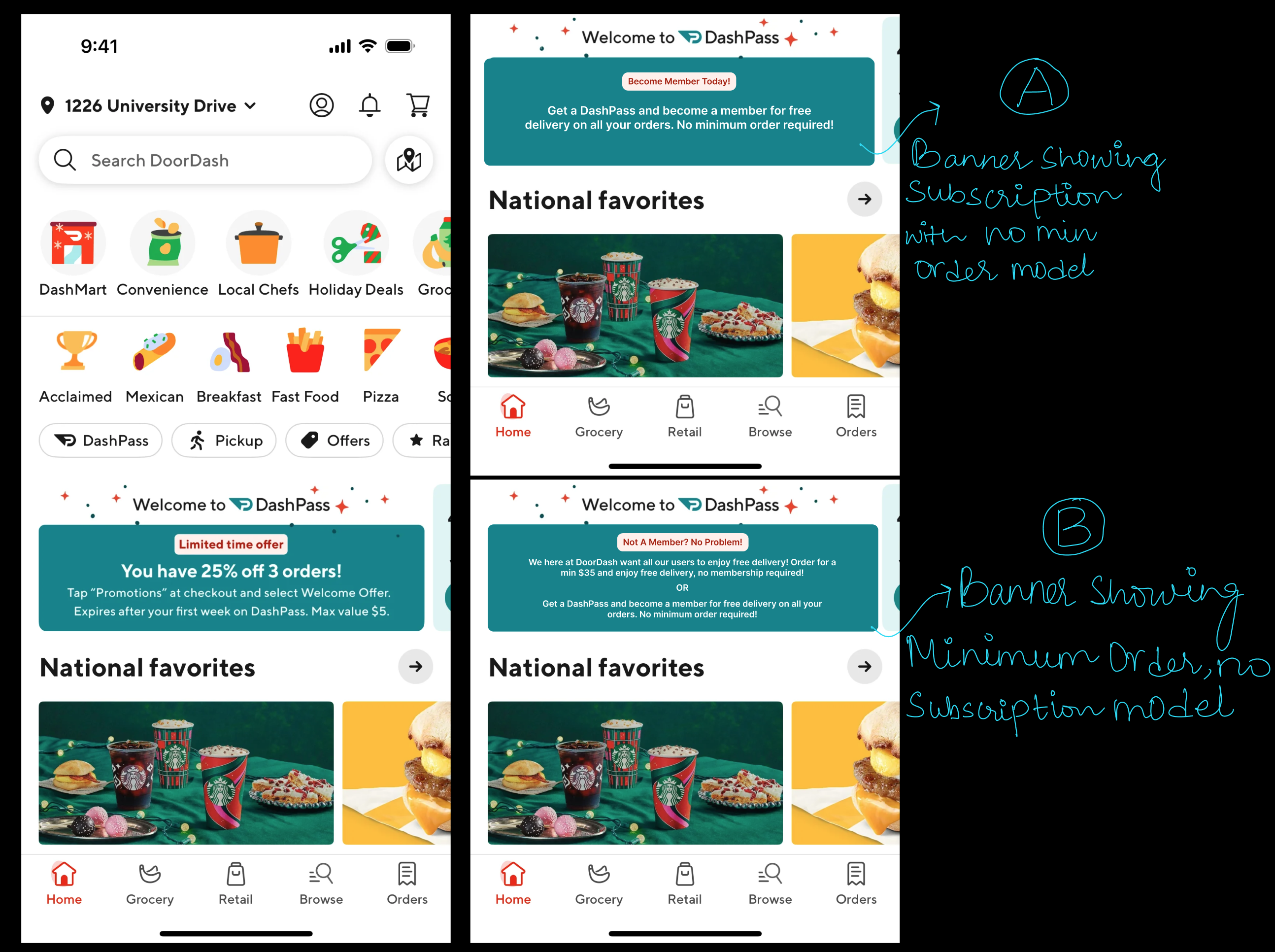
🔸 2: We placed the A/B options on the check-out page of a online retail app
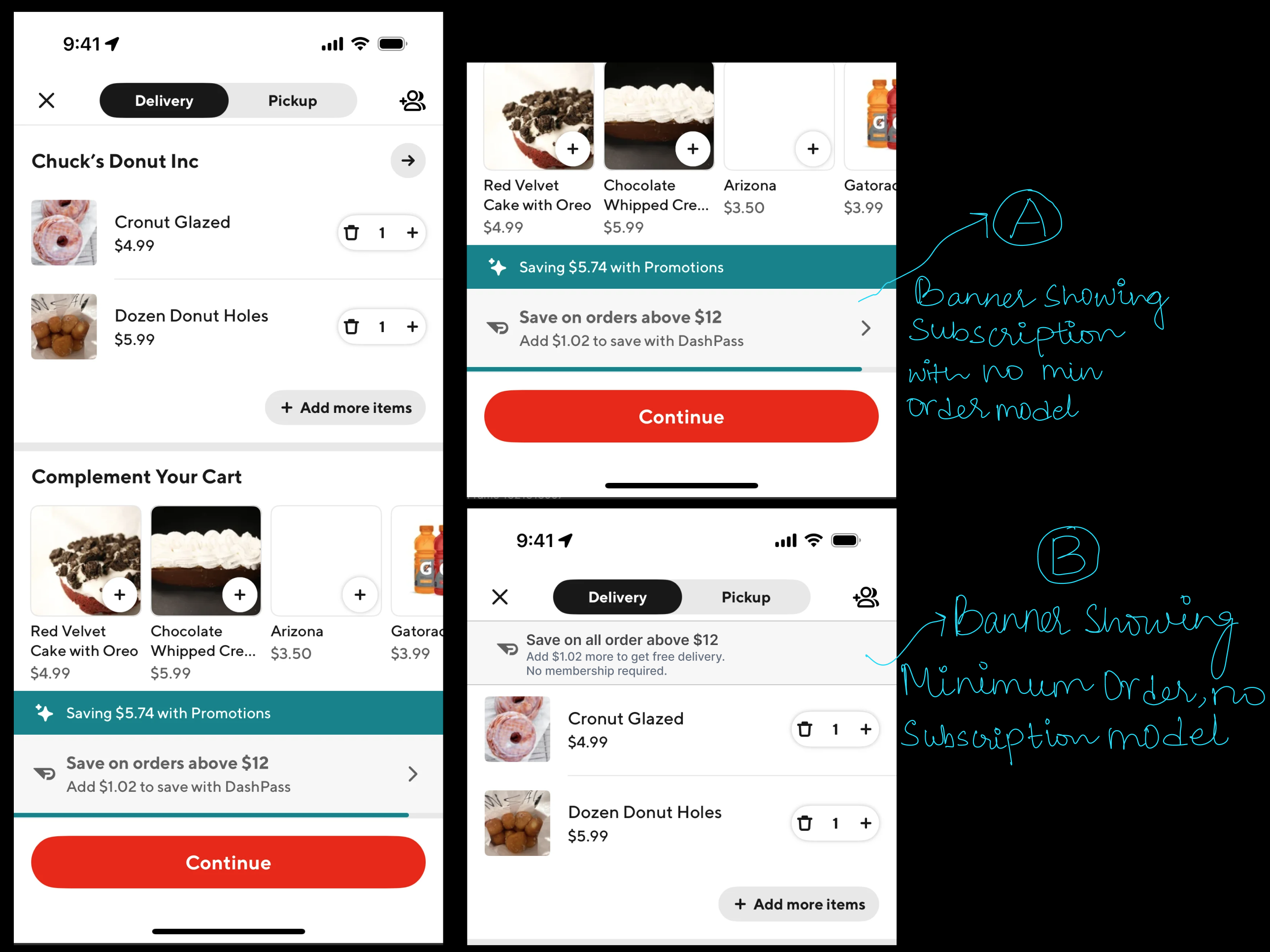
If we had more time in the semester,
we wanted to actually go ahead with the A/B testing and see the results. Most online platforms have this kind of information a little hidden under some tab hence not made very explicit to the customer. With the given time we were only able to design the experiment and not test it. But maybe sometime in the future!